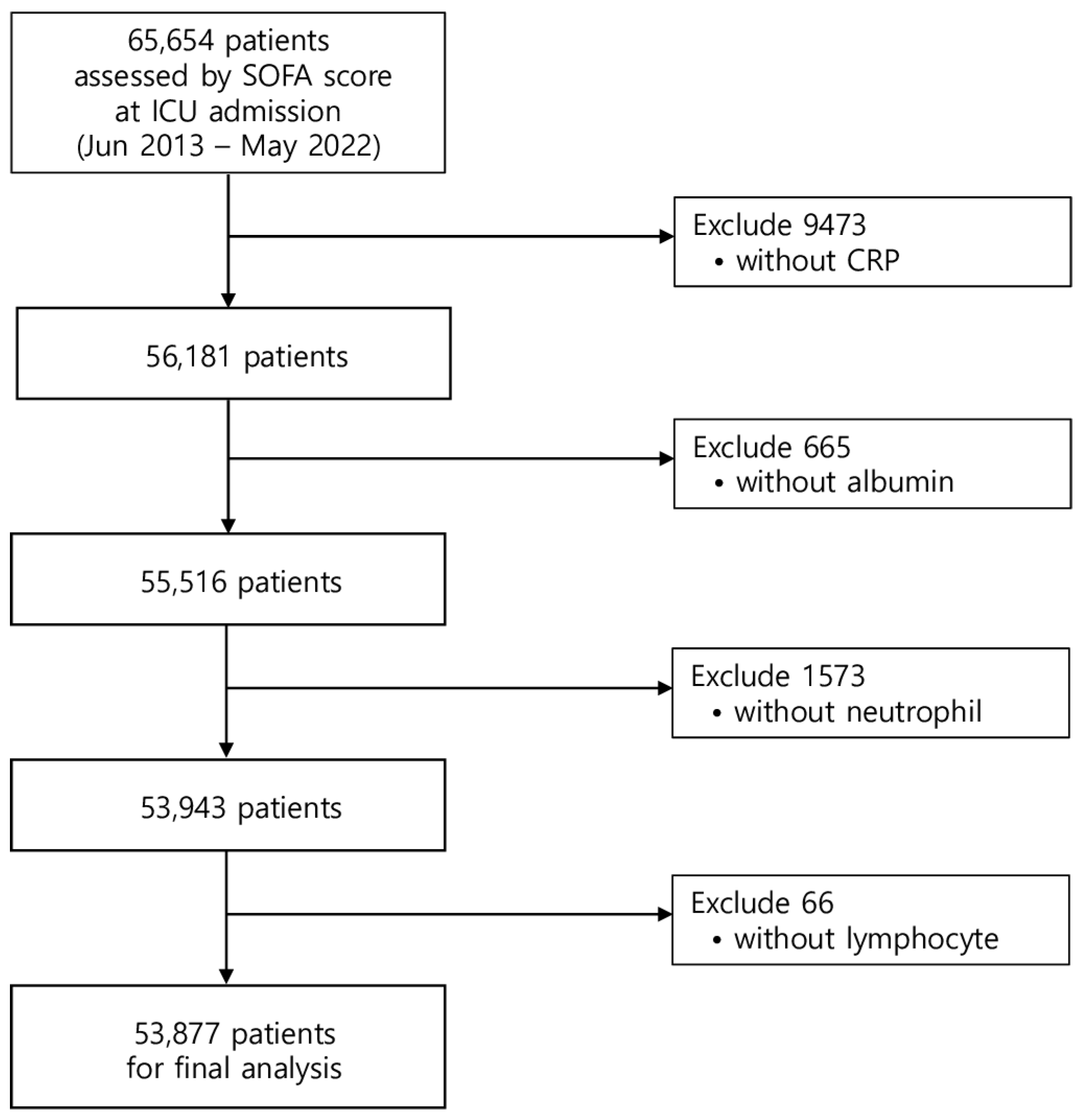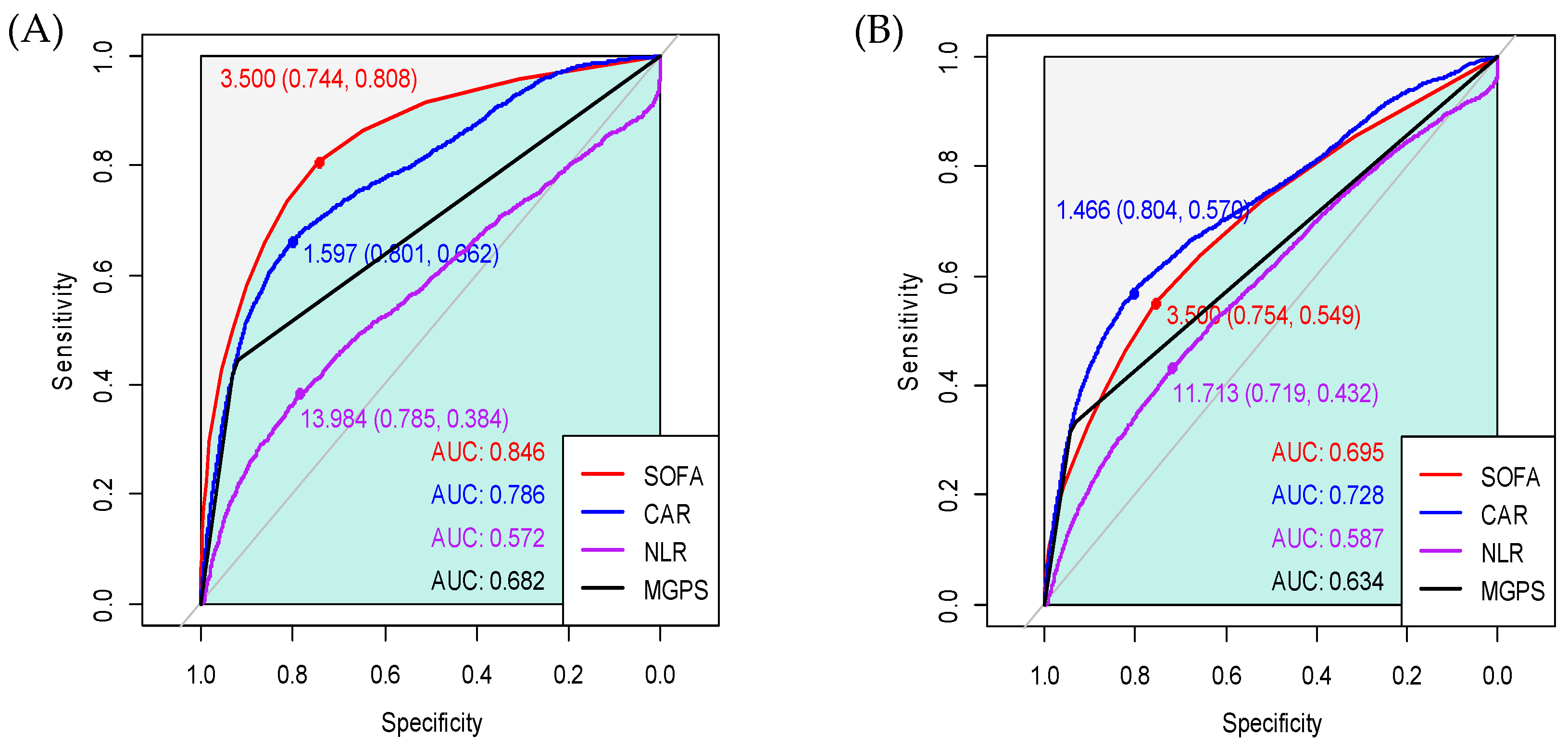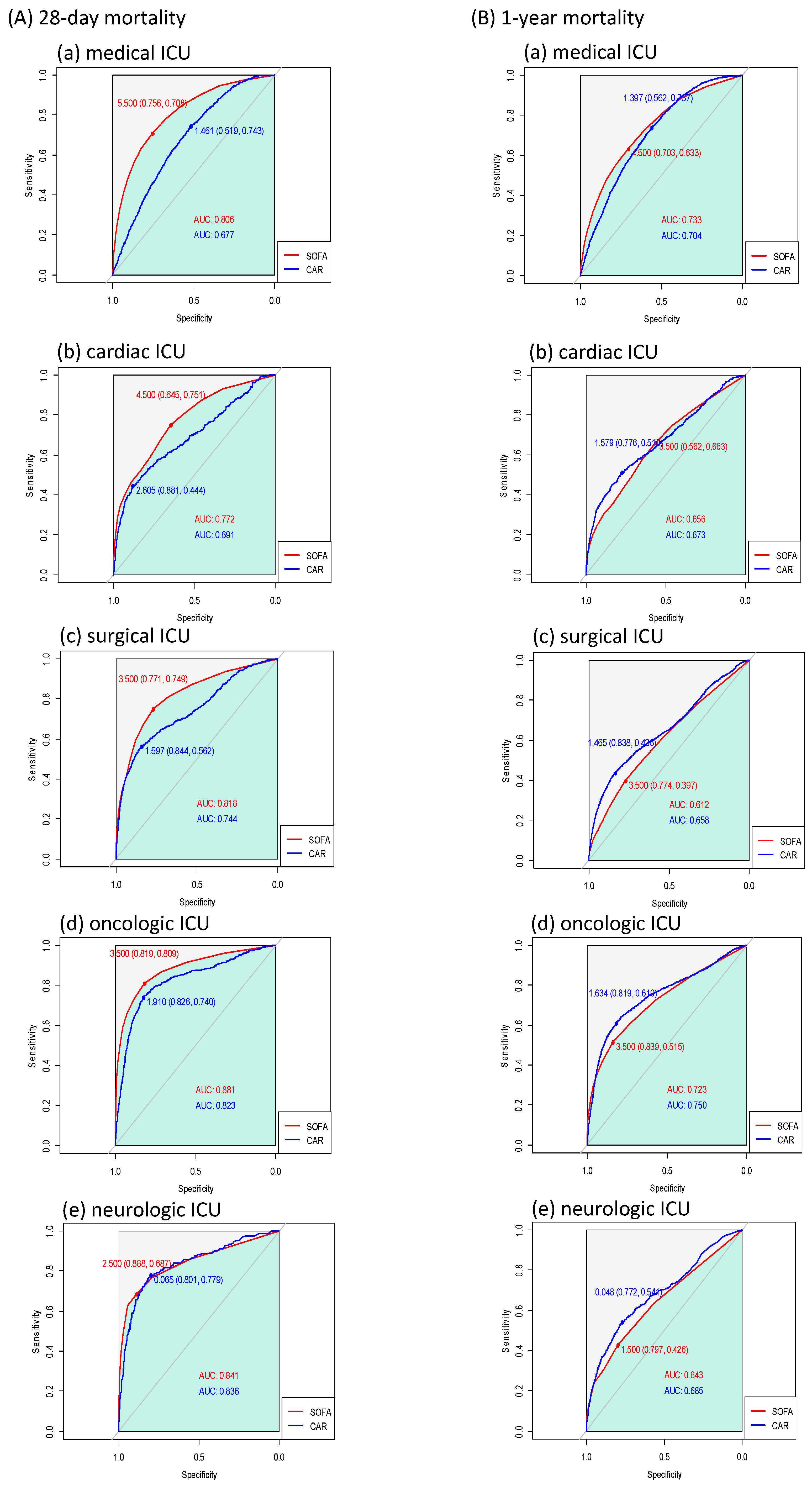Association between Inflammation-Based Prognostic Markers and Mortality in Patients Admitted to Intensive Care Units
Abstract
1. Introduction
2. Methods
2.1. Data Curation and Study Population
2.2. Definitions and Study Endpoints
2.3. Statistical Analysis
3. Results
4. Discussion
5. Conclusions
Author Contributions
Funding
Institutional Review Board Statement
Informed Consent Statement
Data Availability Statement
Conflicts of Interest
Abbreviations
References
- Robertson, L.C.; Al-Haddad, M. Recognizing the critically ill patient. Anaesth. Intensive Care Med. 2013, 14, 11–14. [Google Scholar] [CrossRef]
- Groeger, J.S.; Strosberg, M.A.; Halpern, N.A.; Raphaely, R.C.; Kaye, W.E.; Guntupalli, K.K.; Bertram, D.L.; Greenbaum, D.M.; Clemmer, T.P.; Gallagher, T.J.; et al. Descriptive analysis of critical care units in the United States. Crit. Care Med. 1992, 20, 846–863. [Google Scholar] [CrossRef] [PubMed]
- Lambden, S.; Laterre, P.F.; Levy, M.M.; Francois, B. The SOFA score-development, utility and challenges of accurate assessment in clinical trials. Crit. Care 2019, 23, 374. [Google Scholar] [CrossRef] [PubMed]
- Jones, A.E.; Trzeciak, S.; Kline, J.A. The Sequential Organ Failure Assessment score for predicting outcome in patients with severe sepsis and evidence of hypoperfusion at the time of emergency department presentation. Crit. Care Med. 2009, 37, 1649–1654. [Google Scholar] [CrossRef] [PubMed]
- Li, Y.; Yan, C.; Gan, Z.; Xi, X.; Tan, Z.; Li, J.; Li, G. Prognostic values of SOFA score, qSOFA score, and LODS score for patients with sepsis. Ann. Palliat. Med. 2020, 9, 1037–1044. [Google Scholar] [CrossRef] [PubMed]
- Jain, A.; Palta, S.; Saroa, R.; Palta, A.; Sama, S.; Gombar, S. Sequential organ failure assessment scoring and prediction of patient’s outcome in Intensive Care Unit of a tertiary care hospital. J. Anaesthesiol. Clin. Pharmacol. 2016, 32, 364–368. [Google Scholar] [CrossRef] [PubMed]
- Oh, T.K.; Song, I.A.; Lee, J.H. Clinical usefulness of C-reactive protein to albumin ratio in predicting 30-day mortality in critically ill patients: A retrospective analysis. Sci. Rep. 2018, 8, 14977. [Google Scholar] [CrossRef]
- Ranzani, O.T.; Zampieri, F.G.; Forte, D.N.; Azevedo, L.C.; Park, M. C-reactive protein/albumin ratio predicts 90-day mortality of septic patients. PLoS ONE 2013, 8, e59321. [Google Scholar] [CrossRef]
- Yoldas, H.; Karagoz, I.; Ogun, M.N.; Velioglu, Y.; Yildiz, I.; Bilgi, M.; Demirhan, A. Novel Mortality Markers for Critically Ill Patients. J. Intensive Care Med. 2020, 35, 383–385. [Google Scholar] [CrossRef]
- Regolo, M.; Vaccaro, M.; Sorce, A.; Stancanelli, B.; Colaci, M.; Natoli, G.; Russo, M.; Alessandria, I.; Motta, M.; Santangelo, N.; et al. Neutrophil-to-Lymphocyte Ratio (NLR) Is a Promising Predictor of Mortality and Admission to Intensive Care Unit of COVID-19 Patients. J. Clin. Med. 2022, 11, 2235. [Google Scholar] [CrossRef]
- Pitre, T.; Jones, A.; Su, J.; Helmeczi, W.; Xu, G.; Lee, C.; Shamsuddin, A.; Mir, A.; MacGregor, S.; Duong, M.; et al. Inflammatory biomarkers as independent prognosticators of 28-day mortality for COVID-19 patients admitted to general medicine or ICU wards: A retrospective cohort study. Intern. Emerg. Med. 2021, 16, 1573–1582. [Google Scholar] [CrossRef]
- Vincent, J.L.; Moreno, R.; Takala, J.; Willatts, S.; De Mendonca, A.; Bruining, H.; Reinhart, C.K.; Suter, P.M.; Thijs, L.G. The SOFA (Sepsis-related Organ Failure Assessment) score to describe organ dysfunction/failure. On behalf of the Working Group on Sepsis-Related Problems of the European Society of Intensive Care Medicine. Intensive Care Med. 1996, 22, 707–710. [Google Scholar] [CrossRef] [PubMed]
- Vincent, J.L.; de Mendonca, A.; Cantraine, F.; Moreno, R.; Takala, J.; Suter, P.M.; Sprung, C.L.; Colardyn, F.; Blecher, S. Use of the SOFA score to assess the incidence of organ dysfunction/failure in intensive care units: Results of a multicenter, prospective study. Working group on “sepsis-related problems” of the European Society of Intensive Care Medicine. Crit. Care Med. 1998, 26, 1793–1800. [Google Scholar] [CrossRef] [PubMed]
- Dolan, R.D.; McMillan, D.C. The prevalence of cancer associated systemic inflammation: Implications of prognostic studies using the Glasgow Prognostic Score. Crit. Rev. Oncol. Hematol. 2020, 150, 102962. [Google Scholar] [CrossRef] [PubMed]
- DeLong, E.R.; DeLong, D.M.; Clarke-Pearson, D.L. Comparing the areas under two or more correlated receiver operating characteristic curves: A nonparametric approach. Biometrics 1988, 44, 837–845. [Google Scholar] [CrossRef] [PubMed]
- Ferreira, F.L.; Bota, D.P.; Bross, A.; Melot, C.; Vincent, J.L. Serial evaluation of the SOFA score to predict outcome in critically ill patients. JAMA 2001, 286, 1754–1758. [Google Scholar] [CrossRef] [PubMed]
- Basile-Filho, A.; Lago, A.F.; Menegueti, M.G.; Nicolini, E.A.; Rodrigues, L.A.B.; Nunes, R.S.; Auxiliadora-Martins, M.; Ferez, M.A. The use of APACHE II, SOFA, SAPS 3, C-reactive protein/albumin ratio, and lactate to predict mortality of surgical critically ill patients: A retrospective cohort study. Medicine 2019, 98, e16204. [Google Scholar] [CrossRef] [PubMed]
- Mayr, V.D.; Dunser, M.W.; Greil, V.; Jochberger, S.; Luckner, G.; Ulmer, H.; Friesenecker, B.E.; Takala, J.; Hasibeder, W.R. Causes of death and determinants of outcome in critically ill patients. Crit. Care 2006, 10, R154. [Google Scholar] [CrossRef]
- Winters, B.D.; Eberlein, M.; Leung, J.; Needham, D.M.; Pronovost, P.J.; Sevransky, J.E. Long-term mortality and quality of life in sepsis: A systematic review. Crit. Care Med. 2010, 38, 1276–1283. [Google Scholar] [CrossRef]
- Yende, S.; D’Angelo, G.; Mayr, F.; Kellum, J.A.; Weissfeld, L.; Kaynar, A.M.; Young, T.; Irani, K.; Angus, D.C.; Gen, I.M.S.I. Elevated hemostasis markers after pneumonia increases one-year risk of all-cause and cardiovascular deaths. PLoS ONE 2011, 6, e22847. [Google Scholar] [CrossRef]
- Casalino, E.; Mendoza-Sassi, G.; Wolff, M.; Bedos, J.P.; Gaudebout, C.; Regnier, B.; Vachon, F. Predictors of short- and long-term survival in HIV-infected patients admitted to the ICU. Chest 1998, 113, 421–429. [Google Scholar] [CrossRef] [PubMed][Green Version]
- Haran, C.; Gimpel, D.; Clark, H.; McCormack, D.J. Preoperative Neutrophil and Lymphocyte Ratio as a Predictor of Mortality and Morbidity After Cardiac Surgery. Heart Lung Circ. 2021, 30, 414–418. [Google Scholar] [CrossRef] [PubMed]
- Nguyen, J.M.V.; Ferguson, S.E.; Bernardini, M.Q.; May, T.; Laframboise, S.; Hogen, L.; Bouchard-Fortier, G. Preoperative neutrophil-to-lymphocyte ratio predicts 30 day postoperative morbidity and survival after primary surgery for ovarian cancer. Int. J. Gynecol. Cancer 2020, 30, 1378–1383. [Google Scholar] [CrossRef] [PubMed]
- Forget, P.; Moreau, N.; Engel, H.; Cornu, O.; Boland, B.; De Kock, M.; Yombi, J.C. The neutrophil-to-lymphocyte ratio (NLR) after surgery for hip fracture (HF). Arch. Gerontol. Geriatr. 2015, 60, 366–371. [Google Scholar] [CrossRef]



| Entire Population (N = 53,877) | 28-Day Mortality (N = 2419) | One-Year Mortality (N = 6209) | |
|---|---|---|---|
| SOFA score at ICU admission | 2 (0–4) | 7 (4–11) | 4 (1–8) |
| C-reactive protein/albumin ratio | 0.49 (0.06–1.39) | 3.04 (0.91–6.74) | 1.94 (0.45–5.07) |
| Neutrophil/lymphocyte ratio | 7.90 (4.33–12.82) | 14.33 (4.76–34.09) | 10.09 (5.42–17.82) |
| Modified Glasgow prognostic score | |||
| 0 | 48,547 (90.1) | 1345 (55.6) | 4134 (66.6) |
| 1 | 672 (1.2) | 62 (2.6) | 122 (2.0) |
| 2 | 4658 (8.6) | 1012 (41.8) | 1953 (31.5) |
| C-reactive protein, mg/dL | 1.72 (0.21–4.67) | 8.42 (2.69–17.59) | 5.72 (1.35–13.40) |
| Albumin, g/dL | 3.5 (3.0–3.9) | 2.8 (2.4–3.2) | 2.9 (2.5–3.3) |
| Neutrophil, % | 83.0 (74.5–87.7) | 83.2 (72.0–89.6) | 84.0 (76.0–89.0) |
| Lymphocyte, % | 10.5 (6.7–17.3) | 8.0 (4.4–15.0) | 8.2 (5.0–14.0) |
| Age | 60.47 (±13.84) | 63.11 (±14.08) | 63.35 (±14.42) |
| Male | 31,879 (59.2) | 1537 (63.5) | 4037 (65.0) |
| Comorbidities | |||
| Hypertension | 22,095 (59.2) | 1010 (41.8) | 2524 (40.7) |
| Malignancy | 21,118 (39.2) | 537 (22.2) | 2239 (36.1) |
| Diabetes mellitus | 11,941 (22.2) | 651 (26.9) | 1644 (26.5) |
| Chronic kidney disease | 2350 (4.4) | 140 (5.8) | 322 (5.2) |
| Chronic liver disease | 3041 (5.6) | 269 (11.1) | 600 (9.7) |
| Chronic obstructive pulmonary disease | 1960 (3.6) | 108 (4.5) | 267 (4.3) |
| Stroke | 2604 (4.8) | 107 (4.4) | 283 (4.6) |
| Heart failure | 837 (1.6) | 61 (2.5) | 132 (2.1) |
| Coronary artery disease | 3448 (6.4) | 170 (7.0) | 413 (6.7) |
| Habitual risk factors | |||
| Current smoker | 4647 (8.6) | 190 (7.9) | 443 (7.1) |
| Alcohol intake | 10,223 (19.0) | 364 (15.0) | 781 (12.6) |
| Cause of ICU admission | |||
| Severe trauma | 149 (0.3) | 12 (0.5) | 18 (0.3) |
| Perioperative management | 40,481 (75.1) | 391 (16.2) | 249 (40.1) |
| Post-cardiac-arrest syndrome | 312 (0.6) | 118 (4.9) | 143 (2.3) |
| Neurological disorder | 3050 (5.7) | 135 (5.6) | 298 (4.8) |
| Respiratory distress | 3243 (6.0) | 829 (34.3) | 1460 (23.5) |
| Cardiovascular disease | 3831 (7.1) | 404 (16.7) | 799 (12.9) |
| Abdominal disorder | 892 (1.7) | 173 (7.2) | 305 (4.9) |
| Others | 1919 (3.6) | 357 (14.8) | 695 (11.2) |
| ICU management | |||
| Mechanical ventilation | 10,699 (19.9) | 1449 (59.9) | 2641 (42.5) |
| Continuous renal replacement therapy | 1496 (2.8) | 505 (20.9) | 719 (11.6) |
| Extracorporeal membrane oxygenation | 1405 (2.6) | 171 (7.1) | 284 (4.6) |
| Use of vasopressor | 8282 (15.4) | 1109 (45.8) | 1874 (30.2) |
| No Mortality | Mortality | Unadjusted Analysis | Adjusted Analysis | |||
|---|---|---|---|---|---|---|
| 28-day Follow-up | N = 51,458 | N = 2419 | OR (95% CI) | p-value | OR (95% CI) | p-value |
| SOFA score at ICU admission | 1 (0–4) | 7 (4–11) | 1.41 (1.40–1.43) | <0.001 | 1.31 (1.29–1.33) | <0.001 |
| C-reactive protein/albumin ratio | 0.45 (0.06–1.28) | 3.04 (0.91–6.74) | 1.32 (1.30–1.33) | <0.001 | 1.05 (1.03–1.07) | <0.001 |
| Neutrophil/lymphocyte ratio | 7.84 (4.33–12.83) | 14.33 (4.76–34.09) | 1.00 (1.00–1.01) | <0.001 | 1.01 (1.00–1.02) | <0.001 |
| Modified Glasgow prognostic score | 3.12 (2.99–3.26) | <0.001 | 1.19 (1.08–1.30) | <0.001 | ||
| 0 | 47,202 (91.7) | 1345 (55.6) | ||||
| 1 | 610 (1.2) | 62 (2.6) | ||||
| 2 | 3646 (7.1) | 1012 (41.8) | ||||
| One-year Follow-up | N = 47,668 | N = 6209 | OR (95% CI) | p-value | OR (95% CI) | p-value |
| SOFA score at ICU admission | 1 (0–3) | 4 (1–8) | 1.24 (1.23–1.25) | <0.001 | 1.16 (1.15–1.17) | <0.001 |
| C-reactive protein/albumin ratio | 0.42 (0.05–1.17) | 1.94 (0.45–5.07) | 1.33 (1.32–1.35) | <0.001 | 1.14 (1.12–1.16) | <0.001 |
| Neutrophil/lymphocyte ratio | 7.71 (4.22–12.57) | 10.09 (5.42–17.82) | 1.00 (1.00–1.00) | <0.001 | 1.00 (1.00–1.00) | 0.01 |
| Modified Glasgow prognostic score | 2.78 (2.69–2.87) | <0.001 | 1.08 (1.00–1.16) | 0.04 | ||
| 0 | 44,413 (93.2) | 4134 (66.6) | ||||
| 1 | 550 (1.2) | 122 (2.0) | ||||
| 2 | 2705 (5.7) | 1953 (31.5) | ||||
| No Mortality | Mortality | Unadjusted Analysis | ||
|---|---|---|---|---|
| Medical ICU | N = 6887 | N = 1533 | OR (95% CI) | p-value |
| SOFA score at ICU admission | 3 (1–5) | 8 (5–12) | 1.33 (1.32–1.35) | <0.001 |
| C-reactive protein/albumin ratio | 1.34 (0.17–4.19) | 3.75 (1.41–7.45) | 1.13 (1.12–1.15) | <0.001 |
| Neutrophil/lymphocyte ratio | 7.72 (3.76–14.86) | 10.16 (4.00–21.50) | 1.01 (1.01–1.02) | <0.001 |
| Modified Glasgow prognostic score | 1.61 (1.52–1.71) | <0.001 | ||
| 0 | 4788 (69.5) | 744 (48.5) | ||
| 1 | 256 (3.7) | 43 (2.8) | ||
| 2 | 1843 (26.8) | 746 (48.7) | ||
| Cardiac ICU | N = 12,125 | N = 330 | ||
| SOFA score at ICU admission | 3 (1–6) | 8 (4–12) | 1.33 (1.29–1.37) | <0.001 |
| C-reactive protein/albumin ratio | 0.64 (0.20–1.47) | 1.94 (0.52–4.63) | 1.35 (1.31–1.39) | <0.001 |
| Neutrophil/lymphocyte ratio | 6.38 (3.49–11.77) | 10.01 (5.69–17.50) | 1.03 (1.03–1.04) | <0.001 |
| Modified Glasgow prognostic score | 2.76 (2.44–3.13) | <0.001 | ||
| 0 | 4788 (69.5) | 744 (48.5) | ||
| 1 | 256 (3.7) | 43 (2.8) | ||
| 2 | 1843 (26.8) | 746 (48.7) | ||
| Surgical ICU | N = 42,092 | N = 805 | ||
| SOFA score at ICU admission | 1 (0–3) | 7 (3–10) | 1.39 (1.36–1.41) | <0.001 |
| C-reactive protein/albumin ratio | 0.41 (0.05–1.09) | 2.00 (0.41–5.21) | 1.37 (1.34–1.39) | <0.001 |
| Neutrophil/lymphocyte ratio | 7.97 (4.56–12.71) | 10.00 (5.00–17.48) | 1.00 (0.99–1.01) | 0.08 |
| Modified Glasgow prognostic score | 3.42 (3.16–3.69) | <0.001 | ||
| 0 | 40,167 (95.4) | 537 (66.7) | ||
| 1 | 307 (0.7) | 16 (2.0) | ||
| 2 | 1618 (3.8) | 252 (31.3) | ||
| Oncologic ICU | N = 22,992 | N = 1097 | ||
| SOFA score at ICU admission | 1 (0–3) | 7 (4–11) | 1.59 (1.56–1.63) | <0.001 |
| C-reactive protein/albumin ratio | 0.68 (0.25–1.45) | 4.07 (1.82–7.66) | 1.34 (1.32–1.36) | <0.001 |
| Neutrophil/lymphocyte ratio | 8.78 (5.73–13.00) | 8.89 (2.95–20.44) | 1.01 (1.00–1.01) | <0.001 |
| Modified Glasgow prognostic score | 3.54 (3.32–3.78) | <0.001 | ||
| 0 | 20,976 (91.2) | 518 (47.2) | ||
| 1 | 220 (1.0) | 23 (2.1) | ||
| 2 | 1796 (7.8) | 556 (50.7) | ||
| Neurologic ICU | N = 9179 | N = 163 | ||
| SOFA score at ICU admission | 0 (0–1) | 4 (2–7) | 1.89 (1.78–2.01) | <0.001 |
| C-reactive protein/albumin ratio | 0.02 (0.01–0.05) | 0.40 (0.08–1.68) | 1.66 (1.54–1.80) | <0.001 |
| Neutrophil/lymphocyte ratio | 5.25 (2.35–9.95) | 11.33 (6.35–18.01) | 1.06 (1.05–1.08) | <0.001 |
| Modified Glasgow prognostic score | 5.58 (4.29–7.17) | <0.001 | ||
| 0 | 9110 (99.2) | 137 (84.0) | ||
| 1 | 18 (0.2) | 3 (1.8) | ||
| 2 | 51 (0.6) | 23 (14.1) | ||
Disclaimer/Publisher’s Note: The statements, opinions and data contained in all publications are solely those of the individual author(s) and contributor(s) and not of MDPI and/or the editor(s). MDPI and/or the editor(s) disclaim responsibility for any injury to people or property resulting from any ideas, methods, instructions or products referred to in the content. |
© 2024 by the authors. Licensee MDPI, Basel, Switzerland. This article is an open access article distributed under the terms and conditions of the Creative Commons Attribution (CC BY) license (https://creativecommons.org/licenses/by/4.0/).
Share and Cite
Oh, A.R.; Ryu, J.-A.; Lee, S.J.; Kim, C.S.; Lee, S.M. Association between Inflammation-Based Prognostic Markers and Mortality in Patients Admitted to Intensive Care Units. Diagnostics 2024, 14, 1709. https://doi.org/10.3390/diagnostics14161709
Oh AR, Ryu J-A, Lee SJ, Kim CS, Lee SM. Association between Inflammation-Based Prognostic Markers and Mortality in Patients Admitted to Intensive Care Units. Diagnostics. 2024; 14(16):1709. https://doi.org/10.3390/diagnostics14161709
Chicago/Turabian StyleOh, Ah Ran, Jeong-Am Ryu, Seung Joo Lee, Chung Su Kim, and Sangmin Maria Lee. 2024. "Association between Inflammation-Based Prognostic Markers and Mortality in Patients Admitted to Intensive Care Units" Diagnostics 14, no. 16: 1709. https://doi.org/10.3390/diagnostics14161709
APA StyleOh, A. R., Ryu, J.-A., Lee, S. J., Kim, C. S., & Lee, S. M. (2024). Association between Inflammation-Based Prognostic Markers and Mortality in Patients Admitted to Intensive Care Units. Diagnostics, 14(16), 1709. https://doi.org/10.3390/diagnostics14161709






